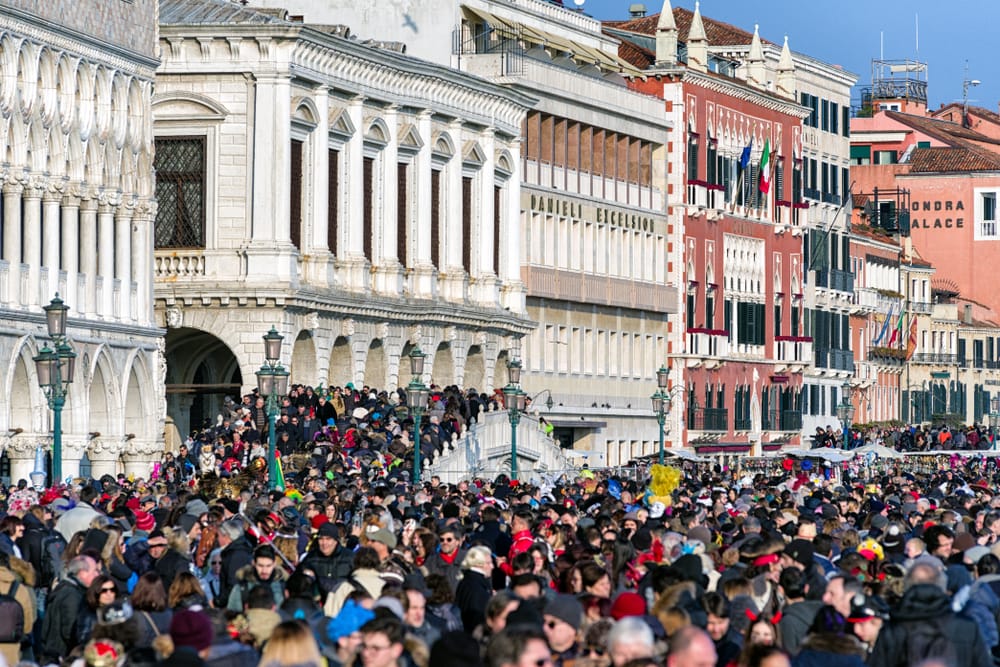Tourism, considered for years one of the most important economic drivers in Europe, has reached levels that are creating tensions. Cities that once welcomed millions of tourists with open arms are now facing the negative effects of mass tourism. The rise of mass tourism, fueled by cheap flights, accommodation platforms, and a growing desire to explore, has led many European destinations to reach a saturation point.
The result has been increasing concern in cities like Barcelona, Venice, and Amsterdam, where infrastructure is overwhelmed, local residents witness drastic changes in their neighborhoods, and natural ecosystems suffer the consequences of a constant flow of visitors. This reality has forced authorities to rethink their approach to tourism, seeking a balance between economic benefits and the quality of life for their citizens.
In this article, we will explore the causes behind this shift in attitude toward tourism, the responses of the most affected destinations, and the evolution toward a tourism model that is quality-driven, conscious, and sustainable.
The Rise of Mass Tourism in Europe
Over the past decades, Europe has solidified its position as one of the most visited continents in the world. Historic cities, idyllic beaches, and rural landscapes attract millions of tourists each year, making tourism one of the main sources of income for many European countries. However, this unstoppable growth has given rise to the phenomenon of “overtourism“, where the massive influx of tourists exceeds the destinations’ capacity to manage them sustainably.
Mass tourism in Europe has been largely driven by the expansion of low-cost airlines, which have made travel affordable for a broader range of people. This, combined with platforms like Airbnb, has revolutionized how tourists interact with cities. With just a click, travelers can book a flight and accommodation anywhere on the continent, democratizing access to the most coveted destinations.
However, this exponential growth has also brought significant problems. Cities like Barcelona, which used to host a few thousand tourists annually, now receive millions, triggering a crisis of tourist overcrowding. This excess of visitors has started to affect the quality of life for residents, who are forced to deal with overcrowded streets, skyrocketing rents, and a culture that adapts more to the needs of tourists than to those of locals.
The Negative Impact of Mass Tourism on European Destinations
Mass tourism has not only brought economic benefits to Europe; it has also generated problems that are eroding the quality of life in many cities. One of the most evident effects is the strain on urban infrastructure. Cities like Venice and Amsterdam, designed to house their residents and a limited number of tourists, are now overwhelmed. Public transport collapses during peak season, main monuments and attractions are packed with people, and basic services like cleaning and waste collection are compromised due to excessive demand.
Moreover, mass tourism has had a devastating impact on the environment and cultural heritage of many European cities. The Mediterranean beaches, which were once tranquil retreats, now suffer from pollution and erosion due to the large number of tourists visiting each summer. Historic landmarks, like the Sagrada Familia in Barcelona or the Colosseum in Rome, are subjected to constant wear and tear from the flow of visitors, leading to accelerated deterioration of these architectural marvels.
Another negative effect of mass tourism is the gentrification of tourist districts. In many cities, local residents have been displaced from their homes due to rising rental prices, driven by the demand from tourists seeking temporary accommodations through platforms like Airbnb. This situation has forced many locals to move to the outskirts, resulting in the loss of the character and authenticity of historic neighborhoods. Barcelona, for example, has seen how traditional districts like El Raval have transformed into areas filled with souvenir shops and tourist restaurants, while local residents struggle to find affordable housing.
The Response of Destinations: Measures to Curb Over-Tourism
Faced with the growing pressure of mass tourism, many European cities have begun to take measures to curb the flow of visitors and mitigate its negative effects. Venice, one of the hardest-hit destinations, has implemented a fee for day-trippers who do not stay overnight. This measure aims to reduce the impact of tourists who arrive en masse, especially by cruise ships, and flood the city during the day without leaving a significant economic contribution.
In Amsterdam, authorities have restricted the opening of new hotels and shops exclusively catering to tourists in the historic center. Additionally, the city has launched campaigns to promote lesser-known areas in and around the city to better distribute the flow of visitors. This strategy seeks to relieve congestion in the center, which has been overwhelmed by tourists, often at the expense of local residents.
Barcelona has opted to strictly regulate vacation rental platforms like Airbnb, imposing fines on owners who rent without a license and limiting the number of tourist apartments in the city. The city has also launched initiatives to promote more responsible and sustainable tourism, encouraging tourists to explore less crowded areas and respect local life.
Quality Tourism vs. Quantity of Tourists: The New Approach of European Destinations
Faced with the unsustainability of mass tourism, many European cities are opting for a new approach: prioritizing the quality of tourism over the quantity of tourists. Instead of focusing on attracting the largest number of visitors possible, the current trend is to attract tourists who bring value to local economies without overburdening the city’s infrastructure and resources.
Quality tourism does not necessarily refer to wealthier tourists but to those interested in a deeper, more respectful experience with the culture and environment of the destination. These travelers seek to experience the city from a more authentic perspective, interact with local residents, purchase fair trade products, and participate in activities that contribute to the sustainability of the place.
Some cities, like Copenhagen and Berlin, have begun to promote more sustainable tourism. These campaigns focus on educating tourists on how to minimize their impact on the city, encouraging the use of public transport, reducing waste, and respecting local rules. The goal is for visitors to become part of the solution rather than the problem.
Does Mass Tourism Have a Future in Europe?
Mass tourism in Europe faces an uncertain future. On the one hand, demand remains high as millions of people worldwide want to visit Europe’s top destinations. However, the saturation of these destinations and the negative effects on local communities and the environment have led many governments to rethink their strategies.
One possible solution is the diversification of tourist destinations. Instead of concentrating visitors in the most popular cities, European countries are starting to promote lesser-known regions that still have much to offer. Portugal, for example, has launched campaigns to promote rural areas like Alentejo, offering a quieter and more authentic alternative to Lisbon and Porto.
Ultimately, the future of tourism in Europe will depend on finding a balance between economic development and sustainability. While tourism is likely to remain a cornerstone of European economies, cities will need to keep innovating to ensure that their residents and the environment do not pay the price for their popularity.

Mass tourism has transformed Europe into one of the most visited regions in the world, but it has also brought considerable challenges. Cities are struggling to balance the economic benefits of tourism with preserving the quality of life for their residents. Adopting more conscious and sustainable tourism seems to be the way forward to avoid the overexploitation of the most popular destinations. Meanwhile, travelers must become aware of their impact and contribute to preserving the cultural and natural richness of the places they visit.







